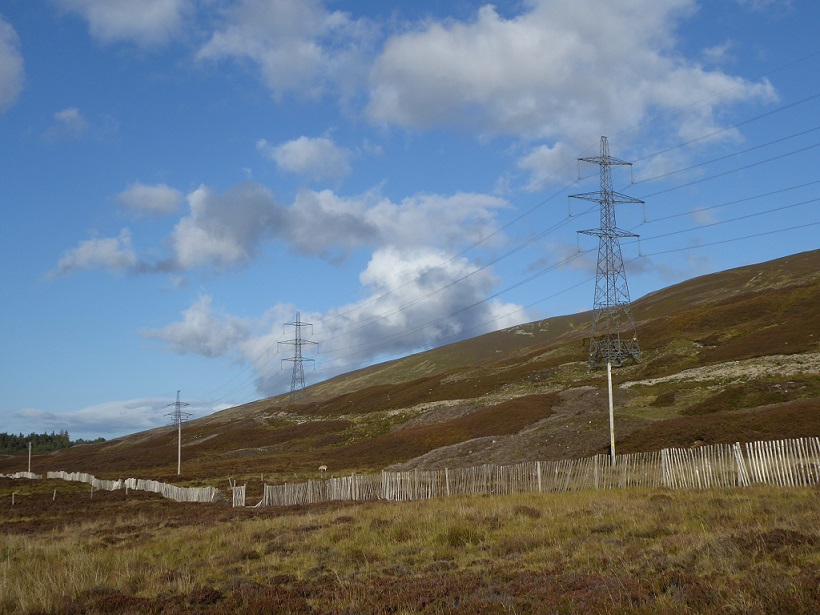
A tourist travelling north through the Drumochter for the first time, on looking up to their right and seeing this scar, might be forgiven for wondering if someone had tried build a new railway through the pass. I doubt they, or many of the thousands of people who cross the Drumochter each year, realise they are travelling down a narrow unprotected strip – just wide enough for the A9 dualling – that runs through what is supposed to be one of Scotland’s most highly protected sites for nature conservation. The boundary of the Drumochter Hills Special Area of Conservation is roughly marked by the snow fence beyond which burned heather, pylons and the scar dominate the landscape.
When Scottish Ministers agreed in 2010, after a lengthy public inquiry, that the Beauly Denny powerline should go ahead in the national interest, they did so on condition that any land disturbed by the construction in the protected areas it crossed should be fully restored. The conditions regarding restoration were specified in a number of detailed planning documents which formed part of the “Energy Consent”. Had Scottish Ministers not stipulated these, they would almost certainly have been challenged in the Courts by the organisations that opposed the powerline using European law.
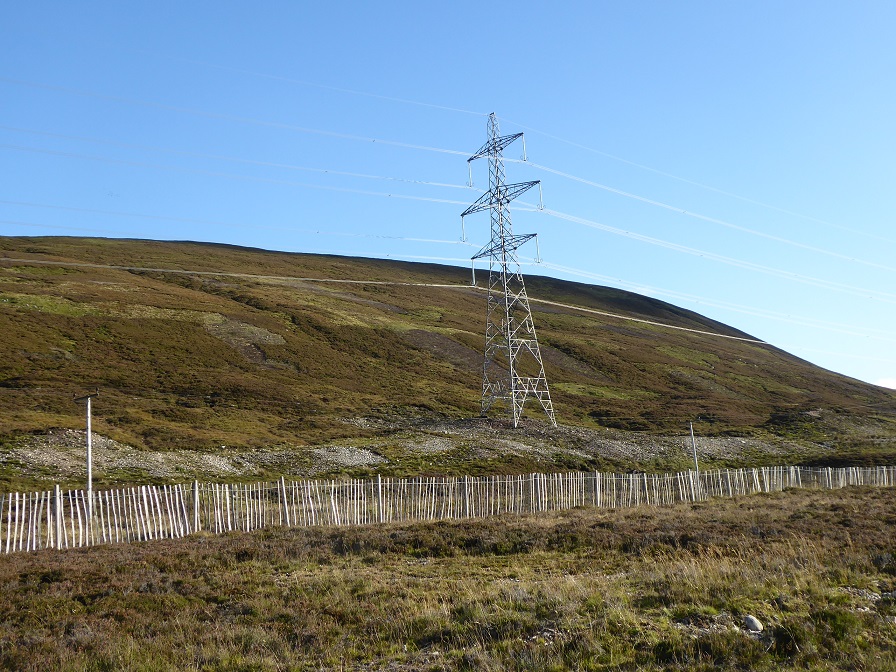
The Beauly Denny went live in December 2015, leaving an enormous landscape scar through the Drumochter Hills Special Area of Conservation (and the Site of Special Scientific Interest which extends towards Dalwhinnie from North Drumochter Lodge). The problem, in a nutshell, was caused by the Scottish Government failing to ensure that Scottish and Southern Energy complied with the planning conditions at the time.
Since then, Scottish Government officials have effectively passed the buck to the Cairngorms National Park Authority and SNH, now NatureScot, to try and work out how the site might be restored (see here). Both organisations are hamstrung so long as the Scottish Government is unprepared to force the developer to pay for the land to be properly restored. The current plan, in essence, is to hope that nature recovers.To assist with this the estate has stopped driving vehicles along the scar and fencing has been erected around one of the worst areas.
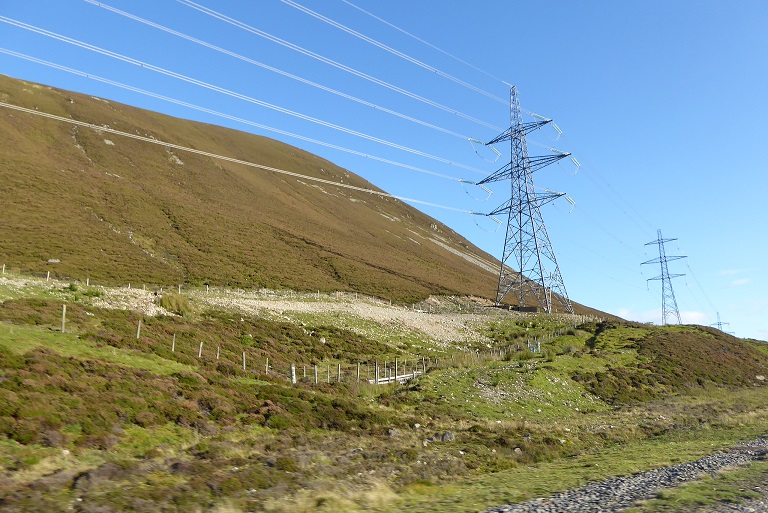
The fundamental issues, which if addressed would take a severe dent out of the profits SSE made from the Beauly Denny, remain: the bulldozed line through glacial landforms, which has left the scar on the landscape and altered drainage patterns on the hillside; the destruction of peat and the creation of new mineral soils; the changes in the vegetation which result from this. Nature will over time modify the destruction, it always does, but in doing so it will create something new, not restore what the SAC was intended to protect.
Having got nowhere in three and a half years of campaigning and blogging (see here and here for example) I decided to take the matter up with the EU (see here). So in January, just before the final deadline for doing so, I submitted a complaint about the failure of the Scottish Government to protect the Drumochter Hills SAC. The EU Complaints Unit replied in March (see here). The important bit reads as follows:

![]()
The whole point of my complaint was the Scottish Government has refused to deal with it “nationally”.
The only remedy I had left was legal action and only a handful of organisations in Scotland, if any, could afford to take on Scottish and Southern Electric and the Scottish Government.
And the EU’s explanation for this?
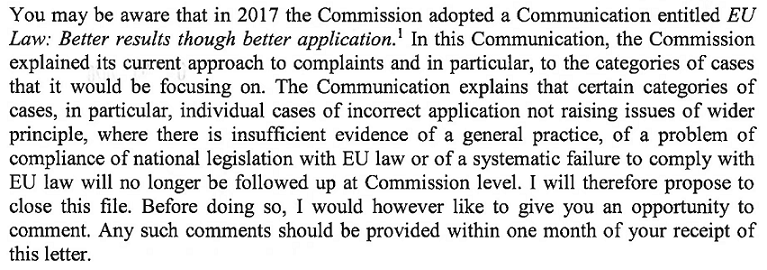
Making it impossible to complain gets better results……..like the 2km scar that runs across the Drumochter Hills SAC.
It was clearly pointless to try and take this any further with the EU. But it does help illustrate why the EU’s legal framework for protecting habitats and wildlife has done so little to prevent the catastrophic decline we have seen in Scotland. This was well documented by the state of nature report (see here) published last year:
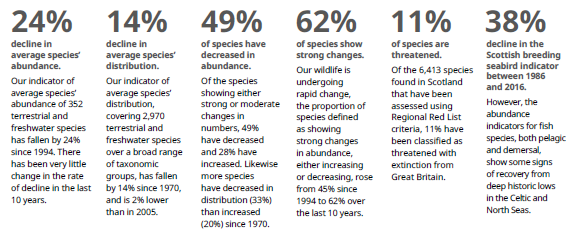
Currently, the Scottish Parliament is considering the Withdrawal from the European Union (Scotland) Continuity Bill (see here):
“This Bill does 3 main things. It:
- gives Scottish Ministers power to keep devolved laws similar to EU laws
- ensures Scottish Ministers and public bodies pay attention to environmental principles when they make policies
- sets up a new organisation to replace the oversight of environmental law provided by the EU”
A large chunk of the bill sets out how the environmental framework developed by the EU will be continued in Scottish law. The implication being that EU environmental law is generally a very good thing despite the evidence we have of how our wildlife has collapsed. As an example:
” 55. The purpose of the duties on the Scottish Ministers and public authorities under the Bill is to promote a high level of environmental protection and sustainable development in Scotland. This will be a key part of delivering on Scottish Ministers’ commitment to maintain EU standards on environmental protection following the UK’s exit from the EU.” (extract from Policy Memorandum see here)
Now, I fully appreciate why so many environmental organisations are concerned that we retain the environmental framework developed under the EU, including designated sites such as Special Areas of Conservation. A Trumpian type alternative could be far far worse and there has been legislation, like that stemming from the Water Framework Directive, that has been progressive. But the Natura Sites set up under the Habitats and Birds Directives have been generally ineffective, as is illustrated by the continued persecution of birds of prey in the Cairngorms Special Protection Area and the continued intensification of grouse moor management, and are not fit for purpose. Instead of continuing with more of the same, the Scottish Parliament should be taking the opportunity to strengthen our environmental laws to prevent environmental crisis becoming even worse.
Besides stronger laws, however, we also need them to be enforced properly. The new organisation the Scottish Government is proposing to create to oversee the law will be known as Environmental Standards Scotland. Recruitment to its non-statutory precursor is already well under way (see here). A good test of its likely effectiveness is whether it will be able, legally, to take action in cases that preceded its creation and if so whether it does so.
We should hope and expect that Environmental Standards Scotland will be far more effective than the EU in holding the Scottish Government to account for the damage that has been to the Drumochter Hills SAC and places like it. If this time next year proper work has been started, with skilled environmental contractors, anyone in Scotland who cares about conservation should be delighted. But I wouldn’t hold your breath.
Postscript
After writing this, I realised I should have mentioned Scottish Environment Link’s new campaign to strengthen environmental law (see here). While I disagree with their claim that EU Membership offered important environmental safeguards, I strongly support the objectives of the campaign which would result in stronger protections than those supposedly offered by the EU.
“But the Natura Sites set up under the Habitats and Birds Directives have been generally ineffective, as is illustrated by the continued persecution of birds of prey in the Cairngorms Special Protection Area and the continued intensification of grouse moor management, and are not fit for purpose.”
Apples and oranges. The failure to address persecution of birds of prey has nothing to do with Natura Sites and the Habitats and Birds Directives. It has everything to do with ineffective enforcement of laws in the UK. Which I think is what the EU said in so many words.
I agree both Scottish and UK governments have failed to enforce EU directives but if those directives were effective the EU would have taken action against the UK and Scottish Governments while we were members. Whether Drumochter SAC or Cairngorms SPA the EU was as ineffective as our governments. The problems, in my view, are at all levels from planning authorities upwards.
Remember the Scottish government has previously ignored eu directives letting ineos away with breeching maximum safe night time noise pollution levels in central Scotland resulting in untold suffering for local residents these eu safeguards were ignored in favour of the oil industry and then all censored by Nicolasnp henchmen